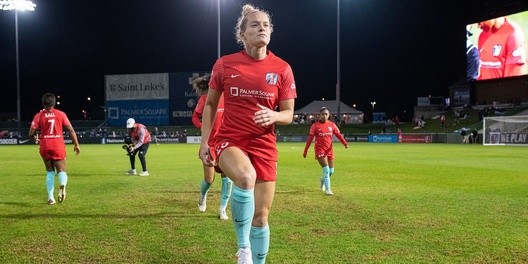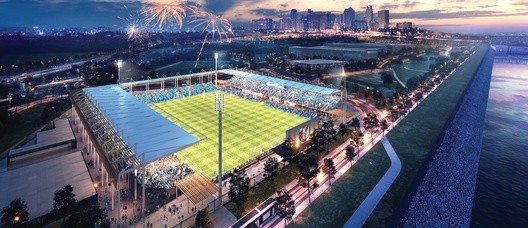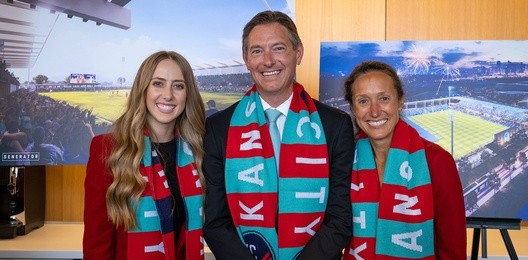Kansas City Current: Building the first women’s soccer stadium in the world

PR | Kristen Hamilton, forward Kansas City Current
Kansas City Current, which plays in the National Women’s Soccer League, committed $70 million in 2021 to create the first stadium purpose-built for a women’s team.
The goal was set when the ownership group was formed knowing the important role facilities play in the success of leagues around the world.
Having control of the revenue opportunities means controlling more of the economic drivers.
The stadium is designed to not only benefit the team, but also the city and the region more broadly.
15 December 2021 - 6:30 PM
Big moments in sports are often characterized by those athletes reaching the stratosphere ever so briefly when greatness reveals itself.
Who can forget when Argentine legend Lionel Messi took the mantle from fellow countrymen Diego Maradona in 2007 during the Copa del Rey semi-finals, hot-footing it down the pitch and scoring an astounding goal—a goal that has gone down as one of the finest strikes in all of football.
But, there also exist those special moments that happen off the field that are ultimately transformative and to the benefit of the entire landscape.
October 26, 2021 has now been recorded in the history annals of sports with the official announcement that the ownership group of Kansas City Current is committing $70 million to create the world’s first stadium purpose-built for a women’s team.
“We are really humbled and honored by the incredible outpouring of support for what we are doing and that alone certainly speaks to us as far as how excited people are about the future of women’s sports,” says Chris Long, Co-Founder and Co-Owner of Kansas City Current, which plays in the National Women’s Soccer League.
The club is based in Kansas City, Missouri and is one of the newest franchises in the NWSL.
Husband and wife team Angie and Chris Long, finance executives who run their own investment management firm, Palmer Square Capital Management, lead the ownership group.
They announced in December 2020 that they had purchased the NWSL’s Utah Royals and were relocating the team to Kansas City.
Former soccer player and fitness entrepreneur Brittany Matthews rounds out the triad of the ownership group that is privately, and solely, financing the stadium.

Interview: “Those clubs that see the real value that women’s football creates will maintain their investment”
5 August 2020 - 1:36 PM
This goal was set at the beginning of their journey.
“From the get go we believed that world class facilities were absolutely part and parcel with world class athletes, and as we considered not only the economics of the club and what we were doing, but also the impact facilities had on other leagues and the future of those leagues, it became apparent to us that that was a must-have,” Chris Long says.
A great trend
Long points to the issue of control in a club owning its own stadium.
“With your own facility, you control a lot more of the economic drivers,” he says.
These include the revenue opportunities that get created through things like naming rights, branded stores, and the myriad ways to connect corporate and community sponsors to the team.
“What that does is allow for more investment through the recycling of those dollars into bigger things that put an even higher trajectory for what we already know is a great trend in women’s soccer,” says Long.
He also emphasizes the importance of having a first-class stadium to support media rights, noting that is highly valued by all—and is one of the key drivers on the future of women’s sports overall.

PR | New Kansas City Current stadium
A careful study of Major League Soccer demonstrated that the development of ‘right-sized’ soccer specific stadiums was critical to its success. This is the blueprint for the Kansas City Current construct.
The team signed a 50-year lease for a 7.08-acre site on the east end of the Berkley Riverfront in Kansas City.
The stadium will start with a seating capacity of 11,500 with the ability to nearly double—at 20,500—for future expansion possibilities. The club is eyeing a 2024 launch.
Right-sizing the stadium
This ‘right sizing’ marks the only difference between male and female arenas, in that it will be smaller in comparison to most (if not all) of the male professional-led stadiums.
“We like that right sizing,” says Long.
“We want it to be a phenomenal fan experience. We want the players to see a sold-out stadium at every single match. So we have purposely done that.”
Long points to the high investment in soccer facilities that is transpiring, which is a big indicator that U.S. soccer is experiencing one of the largest growth rates among all of the professional sports.
Austin FC is one example of a club that built a state-of-the-art soccer facility, Q2 Stadium, which opened for play in June 2021, and integrated the heart of the city within every element. For example, quotes from country singers and imagery of musicians embrace the heritage of the region while representing Austin.
This is about thinking beyond the brick-and-mortar and taking a much more deliberate approach to not only constructing the facility, but considering how to successfully integrate to connect to fans, says Long.

PR | Brittany Matthews, Chris Long and Angie Long
Integration takes on even greater meaning when it comes to Kansas City Current’s soccer stadium.
Long notes the personal importance to the club’s owners that the stadium serve as catalytic event. The driving goal became figuring out the best way to maximize opportunities to not simply benefit the team, but benefit the city and the region more broadly.
The group landed on Kansas City’s riverfront—an area that historically has been overlooked, despite the importance it has to its founding.
The stadium serves as a catalytic event
Its origins date back to the 1800s when French fur traders arrived and built cabins along the Missouri River.
Towards the end of the 19th century, in a post Civil War world, a booming town had sprung on the strength of numerous railway lines that were created and the first bridge that was built across the Missouri River allowing for more trade routes and commerce.
The club’s name ties into these ideals, as well. Long notes that it reflects the “river as a current moving forward—a powerful underlying current that is, in our view, like women’s soccer. It is moving faster and has a great powerful momentum to it.”
But, it’s the growth of Kansas City that heralds back to the waterfront that the club wants to acknowledge through the stadium build.
“The riverfront immediately struck us as a place where putting all of these dollars would have a multiplier effect that would not only revitalize the area, but would push that development even more into downtown Kansas City, which is experiencing a massive resurgence. We want to help speed that up even more.”
There are ambitions for it to become a community asset as well. Long says the club would like it to serve as a concert arena, to host high school and college championships and potentially be the venue for FIFA U-17, U-20 and other similar competitions if that were viable.
“We want the stadium to be a place that people really want to be,” says Long.

Interview: The Olympique Lyon-strategy behind the purchase of a US women's team
24 November 2020 - 10:28 PM
Where soccer is concerned, he makes clear the desire for it to be the destination for premier women’s soccer — and perceives it as the means to have a competitive advantage in recruiting and retaining players.
A model for women’s sports broadly
From a pure facilities standpoint, the overall goal is far-reaching: “We would like to see the stadium become a model for women’s sports broadly,” says Long.
Trailblazing raises emotions to euphoric levels, no doubt. But, the deeper meaning of it is not lost on the ownership group.
“We’ve really been overwhelmed, in some respects, with the immense responsibility of doing this right for the players, the fans and the broader community,” he says.
“From an emotional standpoint it’s very exciting. Yet, it’s also steeped in responsibility to get it right.”

